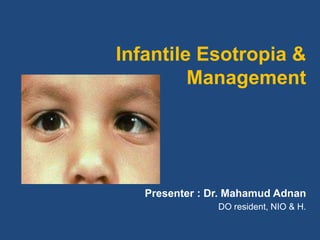
Management of Infantile Esotropia
- 1. Presenter : Dr. Mahamud Adnan DO resident, NIO & H. Infantile Esotropia & Management
- 2. Chairman : Dr. Shovana Alam Associate Professor Pediatric ophthalmology, NIO & H Moderator : Dr.Nusrat Shahrin Assistant Surgeon Pediatric ophthalmology, NIO & H.
- 3. Milestone of Vision : • At birth- Eyes move randomly, no central fixation • At 6 weeks- Apparent fixation reflex , can follow bright light at short distance
- 4. Cont. Milestone of Vision : • At 4-6 months - Convergence established . Foveal reflex developed at 4 th month . Central fixation developed at 6 months. • At 6 years - Foveal development is complete & visual acuity achieved 6/6.
- 5. Visual axis Pupillary line Angle kappa
- 6. Cont. Phoria = latent deviations Tropia = manifest deviations Orthophoria It implies perfect ocular alignment in the absence of any stimulus for fusion.
- 7. Cont. Esotropia : The term ‘esotropia’ is derived from two Greek words ‘eso’ means ‘inward’ and ‘trepe’ means ‘turn’ In esotropia, the eyes are crossed, that is, while one eye looks straight ahead and the other eye is turned in toward the nose.
- 11. Cont. Pseudo-esotropia : is the clinical impression of ocular deviation when no squint is present. Wide nasal bridge Prominent epicanthal folds Narrow interpupillary distance Negative angle kappa Usually with the formation of the bridge of the nose, it disappears.
- 12. Classification of Esotropia Accommodative 1.Refractive: • Fully accommodative • Partially accommodative 2.Non-refractive: • With convergenc excess • With accommodation weakness 3.Mixed Non-accommodative Early onset(Infantile) Microtropia Basic Convergence excess Convergence spasm Divergence insufficiency Divergence Paralysis Sensory Cyclic
- 13. Infantile Esotropia • Definition: Infantile or congenital esotropia is an idiopathic condition developing within first 6 months of life in an otherwise normal infant with no significant refractive error or no limitation of ocular movements. • Prevalence : 27/10,000 live births.
- 15. Etiology • The cause of infantile esotropia remains unknown. Worth Theory – “Sensory” concept – Congenital deficit in a “fusion center” in the brain Chavasse Theory Primary motor misalignment Disruption of binocular vision Potentially curable if ocular alignment is achieved in infancy.
- 16. Risk Factors • Family history • Secondary ocular history • Prematurity • Low birth weight. • Perinatal or gestational complication
- 17. Characteristics • Idiopathic • Within 1st 6 months of life • No significant refractive error(Normally +1.5 D) • Family history(+/-) but not well defined genetic pattern • Otherwise patient is normal
- 18. Signs • Apparent , large angle( >30 PD ) • Alternate fixation in primary position. • Cross fixation in side gaze. • Poor potential for BSV • Amblyopia (+/-) • Nystagmus - horizontal. • Emmetropia / Mild Hypermetropia / Myopia
- 19. Cont. • Associated conditions : - Dissociated vertical deviation (DVD, 75% ) - Inferior oblique overaction ( 70% ) - Latent and manifest nystagmus ( 50% )
- 20. Differential Diagnosis • Pseudo-esotropia • Congenital 6th nerve palsy • Secondary(sensory) esotropia • Duane syndrome • Mobius syndrome
- 21. Evaluation History: 1.Age of onset 2.Head posture 3.Birth history 4.Family history of strabismus 5.Previous ocular history - use of spectacles - occlusion therapy - previous surgery
- 22. Examination • Visual acuity : In preverbal child - Fixation and following - Comparison (occlusion of one eye) - Fixation behaviour test - Rotation test - Preferential looking test - Visual evoked potential
- 26. Cont. Measurement of deviation : • Hirschberg test
- 27. Cont. • Cover-uncover test : - Cover test - uncover test - Alternate cover test - Prism cover test • Krimsky and prism reflection tests
- 29. Cont. • Ocular motility examination : - Versions - Ductions • Refraction and Fundoscopy
- 30. Treatment Aim : - Align visual axis - Enhance binocularity - Improve visual acuity Goal : - Alignment within 10 of orthophoria
- 31. Non Surgical Treatment • Correction of refractive error, if any. • Treat amblyopia • Botulinum toxin inejction into MR
- 32. Without spectacle With spectacle
- 33. Surgical treatment Time of surgery: • Between 6 months to 2 years of age • Recent studies favour early surgery as soon as diagnosis is made • Wait up to 6 months of age in intermittent esotropia or small to moderate angle deviations
- 34. Cont. Before proceeding to surgery: • Deviation should be constant and stable • Accommodative element should be absent • Sensory esotropia should have been ruled out • Amblyopia should be treated optimally • Counseling of parents.
- 35. Surgical Approaches • Bilateral Medial Rectus recession • Ipsilateral MR recession with LR resection • Adjustment of vertical muscles - Weakening IO
- 37. Deviations PD B/L MR recession(m m) Recession of MR Resection of LR 15 03 03 04 20 3.5 3.5 05 30 4.5 4.5 06 40 5.5 5.5 07 50 06 06 08 60 6.5 6.5 09 70 07 07 10
- 38. Before surgery After 01 month
- 39. Post Surgical Outcomes 1. Under correction . 2. Over correction . 3. DVD : - SR recession with or without posterior fixation suture - IO anterior transposition.
- 40. Cont. 4. IO overaction : - Disinsertion - Recession - Myectomy 4. Amblyopia-subsequently develops in 50% of cases
- 41. Cont. 5. Other surgical complications like – - Slipped rectus muscle - Anterior segment ischemia - Cellulitis - Endophthalmitis - Retinal detachment
- 42. Ciancia syndrome A severe form of infantile esotropia, referred to as Ciancia syndrome. Features: Large angle deviation(>50 PD) Abducting nystagmus Mild abduction deficit
- 43. Take home message • Onset of Infantile esotropia is around 4 months of age • This produces profound deficits in binocular vision if not correct promptly. • We should operate early (<2 years) to promote the development of binocular vision and some stereopsis.